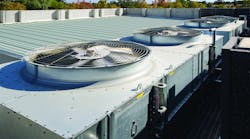Although nine out of 10 Legionnaires' disease cases are preventable, older workers and those with compromised immune systems continue to be diagnosed each year, according to the Centers for Disease Control and Prevention (CDC).
As cases continue to increase, companies and EHS managers should have effective testing and water management plans in place to prevent Legionella, the bacteria which causes Legionnaires' disease, from spreading through a facility's water supply.
To reduce risk of an outbreak in your facility, five steps can be taken to make sure workers are safe from the respiratory illness.
Step One: Validate the Effectiveness of Your Water Management Plan
With ANSI/ASHRAE Standard 188-2015, Legionella water management programs are now an industry standard for large buildings in the United States.2 Large facility water systems can be complex and harbor pathogens. Maintenance, renovations and service interruptions can cause even more hazardous conditions. Routine testing for Legionella pneumophila is the only way to determine if your water management plan is working. “Water sampling is critical to determining whether Legionnaires’ disease bacteria are present and at what levels," OSHA states in its guidelines for Legionnaires' disease.3
Step Two: Test for Legionella pneumophila
A single species of Legionella bacteria, Legionella pneumophila is the primary cause of Legionnaires’ disease. This species is responsible for 99 percent of the outbreaks tracked by the CDC.4,5 Accordingly, Veterans Administration healthcare facilities are required to test for Legionella pneumophila every quarter.6 World Health Organization (WHO) advisors also recommend testing for Legionella pneumophila, “not Legionella species, since this genus contains many species that do not cause illness.”7
Step Three: Rely on a Culture Test
Although rapid tests, such as polymerase chain reaction (PCR) tests, offer faster results in an outbreak situation, culture tests are the only reliable source of accurate quantification of Legionella. PCR and direct fluorescent antibody (DFA) tests do not discriminate between live Legionella and bacteria that have already been controlled and are not a threat to patients. Lateral flow antibody “field tests” only detect a single serotype of all possible Legionella pneumophila and have high false negative results, often missing the pathogen completely.
Step Four: Make Sure Results are Accurate and Reproducible
Routine testing for Legionella pneumophila is the best way to ensure your water management plan is effective. In addition to identifying the presence of L. pneumophila in your system, you’ll need consistent data about the exact quantity and locations of the bacteria to respond appropriately. Safety leaders must have consistent data to make high stakes decisions about potential water quality issues.
Step Five: Choose a Laboratory That is Accredited for Legionella Testing
ANSI/ASHRAE Standard 188-2015 recommends using “a laboratory with demonstrated proficiency in the subject method, such as may be evidenced by certification by a national, regional, or local government agency or by an accredited non-governmental organization.”8 Laboratories that perform Legionella pneumophila testing with a method that is part of their accreditation and quality system demonstrate that their testing is performed at the highest level of quality. Accreditation also affords the best legal protection if testing results ever come under question. ISO 17025 and the Environmental Microbiology Laboratory Accreditation Program (EMLAP; operated by AIHA) are nationally-recognized accreditation options that include a Legionella pneumophila field of testing.
Dan Broder is a scientist and team leader for New Product Development in the R&D Division of the IDEXX Water line of business, where he led the multi-year research and development effort for Legiolert, a culture method for the detection and quantification of Legionella pneumophila. Dan recently presented at the Legionella 2017 conference in Rome, the 2017 AWT Annual Convention and the 2017 UNC Water Microbiology /International Symposium on Health-Related Water Microbiology. He earned his PhD in microbiology from University of Illinois at Urbana-Champaign.
